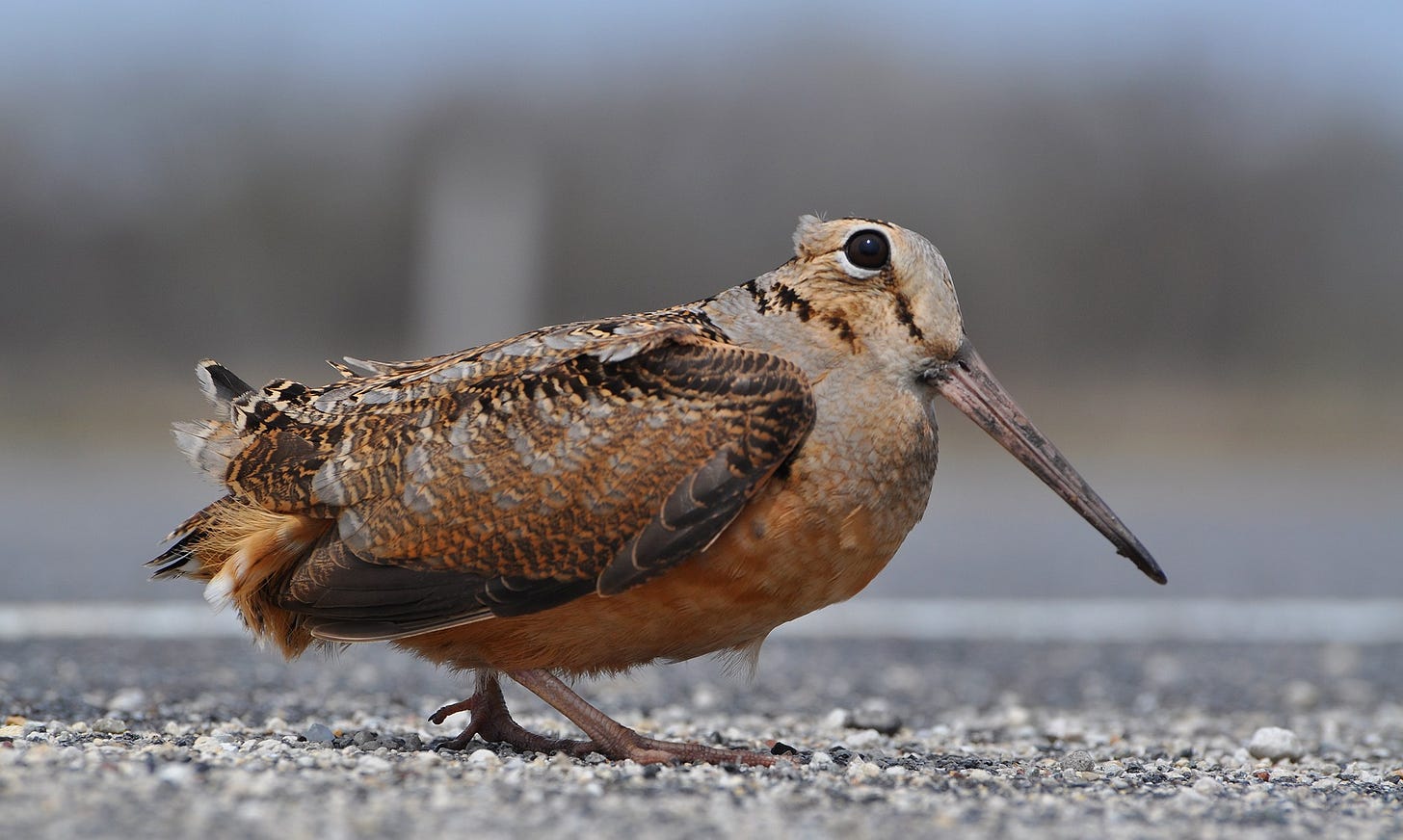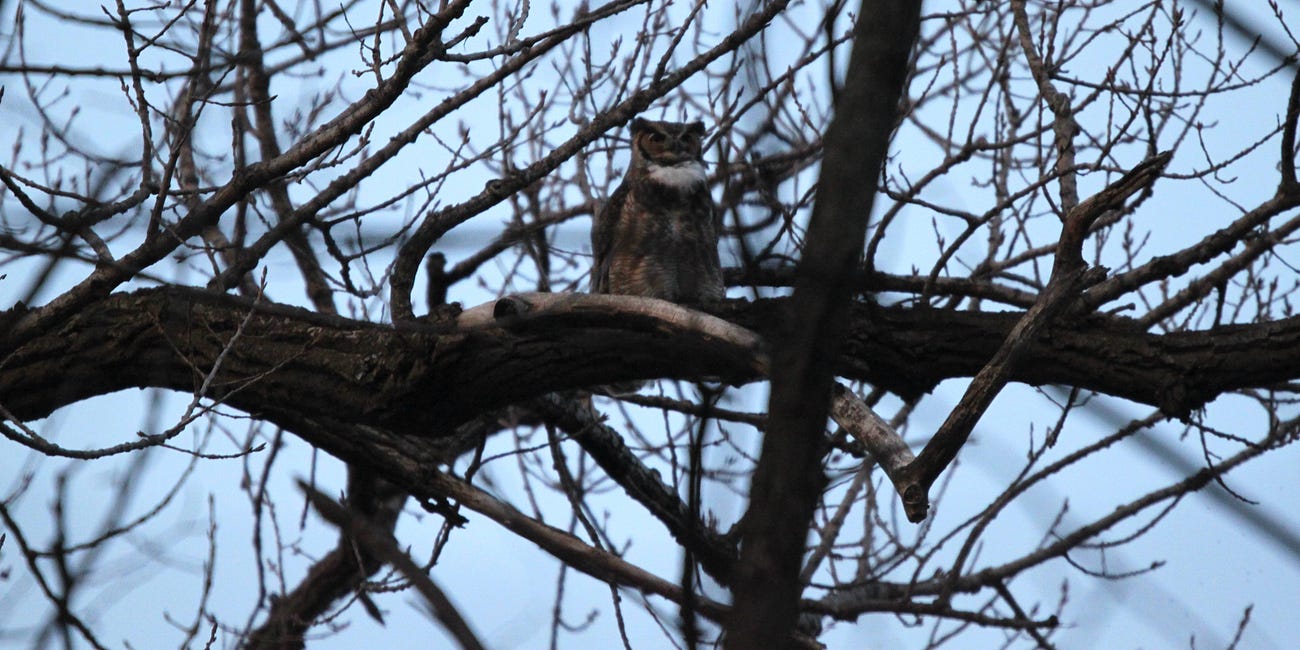A secretive flier arrives by moonlight
Woodcock's return is one of the early signs of spring.
A full moon and blustery south winds aligned perfectly a few days ago as the American Woodcock returned to these climes. The rotund, long-billed woodcock is quite unlike any other bird species in eastern North America. It’s categorized in the sandpiper family, as it often is a bird of damp spots and watery areas, but it’s not like most of its brethren at all.
Woodcocks come in on bright, moonlit nights and when the ground has thawed just enough to probe for worms. Its long, slightly prehensile bill is able to capture invertebrates in the soil well before other species can.
The full moon last week resulted in some arrivals, as well as the warm front that came up from the Gulf. Woodcocks are short-distance migrants, meaning they don’t winter too far south. Think the southern United States, rather than Central or South America. It doesn’t take much warmth for the birds to catch a wind that propels them to northern latitudes.
Woodcocks are most readily observed at dawn or dusk, along wet meadows and waterlogged prairies. I was on a mown path right at sunset when I watched what looked like a large bat flutter directly over me. It was too barrel-chested and round for a bat, though. But one can see why early settlers referred to these buoyant fliers as a “mud bat.”
Male woodcocks try to garner the attention of females almost as soon as they arrive in these parts. To see the woodcock’s display flight, or sky dance, sunset is indeed the time—not at last light or civil twilight. You’ll have a much better chance of getting a visual. My 42mm objective lenses gather a fair bit of detail even in dim light, revealing the birds’ intricate feathering.
The woodcock begins by incrementally “peenting,” which is a somewhat insect-like, buzzy call that also resembles that of the Common Nighthawk. Then it will take off, straight up off the ground, and its wings make a whistling sound on its flight upward. It flies higher than the treetops and the chips become more and more faint until the bird completely disappears for a few moments. It’s estimated they reach heights of 250 to 300 feet. As he plummets, the woodcock makes a melodic chirping sound before returning to earth.
The woodcock will repeat this pattern several times, peenting about five seconds apart for a minute and then disappearing dozens of meters above the oak savanna.
They seem to be even more apparent during full darkness, visible along brushy meadows, but then retreat to the woods at other times including during the day. There’s a non-zero chance you’ll flush one on a walk in daytime this spring, the whoosh of its feathers always providing a little startle. The woodcock will then make a fast, erratic flight away, usually out of sight but not far from the place of flushing.
Some do breed here—they’ll be with us all the way through fall—but they’re secretive and confined to only a few locations that are rather impenetrable in the peak of summer. The male will mate with multiple females; he doesn’t tend to the young at all before heading back south.
Where I find them in migration is on a small restored prairie, uphill from a river. It’s not quite a birding mecca, but it has a nice mix of habitat. Occasionally the birds will circle all the way over the neighborhood rooftops, so I have been able to count the American Woodcock as a “yard bird.”
I’ve been reflecting on why the woodcock is so enchanting. Part of it must be that it is early to arrive after a long dreary winter, when spring migration hasn’t started in earnest, and the February doldrums are still top-of-mind. But there really is no other species in our area with so many unusual behaviors. One also realizes that the species’ survival relies on this odd array of attributes and the near-constant displaying that attracts the notice of other woodcocks and especially females. In a time when there is less and less woodcock habitat these are indicators of a fragile survival. The return of the woodcock is something we can count on in uncertain times, and there’s something reassuring about that when it comes along each March.
Chicago Ornithological Society is marking the return of the mud bat with a series of woodcock walks led by friend of TWiB, Edward Warden. Check out the full schedule, starting March 28. Walks start at sundown, and there’s a good chance you’ll experience this remarkable bird performing its legendary sky dance.
Two years since something extraordinary
Last week marked two years since the third state record Ross’s Gull, found in Chicago at Park No. 566 by Dan Lory. The rare Arctic visitor sent people scrambling from all over the Midwest to get a glimpse. There aren’t many Ross’s Gulls in the world—just about 40,000 according to All About Birds—and one of the more “accessible” viewing sites is at Utqiagvik (formerly Barrow), Alaska.
The species hadn’t been seen in Illinois since 2011, and even then it was just barely seen—by one person on one day. The last “chase-able” sighting was all the way back in 1978; keen-eyed observers might note that an image from that event appears in my 2021 film, “The World of Monty and Rose,” when a line of people set up their cameras and scopes at North Avenue Beach. Chicago really always has been a birding town.
Dan sent out a wonderful account of finding the Ross’s Gull in his newsletter last week. You can check it out here.
If you liked today’s post, you might like this past post:
It's wise to be thoughtful around owls
It’s the time of year to re-visit some of the guidelines for engaging with owls in the field.
I’d like to keep this newsletter free for most subscribers in 2025 and into the future. Any paid subscribers can certainly help with that goal. If you’ve been enjoying this newsletter, I hope you might become a paid subscriber also. Click here to get started or click the button below.






These round balls of complete "adorable" are miracle babies like every other bird is. Some are just a bit more abnormal (IN A GREAT WAY) than others. I live in Pennsylvania so I've never seen one in person...but I'd love to. They look so mild mannered and innocent. Not that every animal isn't innocent...but some species would LITTERALY not harm a fly if given the chance.
I wish I could "meet" every bird in person however lol.
Thanks so much for your fascinating post! I attended Penn State ‘67-‘71. An odd area outside State College called The Barrens had burned a number of times from coal fired locomotives, leaving the ground charred and unable to support normal plant life. Dwarf, twisted oak trees and almost impenetrable scrub brush. On a solo outing to The Barrens one day, a Woodcock flushed in a burst then settled a short distance away. I moved quietly toward its landing spot, hoping for a closer glimpse. Succeeding briefly I saw its staggering body shape and long bill. Off it flew. A species I’d love to see again. Thank you so much Bob Dolgan for your skills!